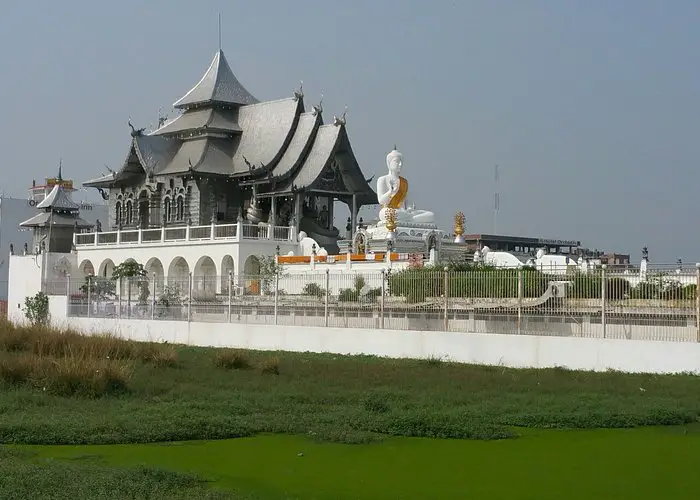Gaya Tourism, Bihar Tourism

This city has historical significance & one of the major tourist attraction in India. Gaya is holy place for Hindus, Jains & Buddhists. This city boast of mentioning in ancient epics of Ramayana & Mahabharatha. Gaya has Vishnu Pad temple where it is belief that Lord Ram, Sita & laxman visited to offer Pind-dan to their ancestors.
Story behind Nomenclature
Gaya is named after Gayasura (Demon) who lived there during Treta Yuga. According Puranas, Gayasur’s body became pious after he performed strict penance and secured blessing from Vishnu. It is common saying that body of Gayasur has become the different hills in & around Gaya.
Historical Importance
ANCIENT
According to modern scholars, the Kikata Kingdom from Rigvedic period was located at Gaya, Bihar. Gaya is an ancient city, with a Buddhist documented history dating back to the 6th century BCE when the sage Gautam Buddha attained enlightenment at Bodh gaya, 16 km (9.9 mi) from the modern city.
Even before this time, Gaya was a place of pilgrimage for people from around the world. The fame of ancient Gaya derived from the account in the Ramayana of the god Rama coming here to the banks of Phalgu river (called the Niranjana), accompanied by his wife and younger brother, to offer Pind-daan for their father Dashratha, for the moksha of his soul. In the Mahabharata, Gaya is referred to as Gayapuri.
Gaya flourished during the Maurya Empire (321–187 BCE), which ruled from the city of Patliputra (adjacent to modern Patna) over an area that extended beyond the Indian subcontinent. During this period, Gaya witnessed the rise and fall of many dynasties in the Magadh region, where it occupied an important place in cultural history over some 2,400 years between the 6th century BCE and the 18th century CE.
The city’s cultural significance began with the dynasty founded by Sisunaga, who exercised power over Patna and Gaya around 600 BCE. Bimbisara, fifth king of the dynasty, who lived and ruled around 519 BCE, had projected Gaya to the outer world. Having attained an important place in the history of civilization, the area experienced the influence of Gautama Buddha and Bhagwan Mahavir during the reign of Bimbisara. After a brief period under the Nanda dynasty (345–321 BCE), Gaya and the entire Magadha region came under Mauryan rule. Mauryan Emperor Ashoka (272–232 BCE) embraced and promoted Buddhism. He visited Gaya, and built the first temple at Bodh Gaya to commemorate the Buddha’s attainment of supreme enlightenment.
MODERN
As attested by Francis Buchanan- Hamilton in the early nineteenth century, the city was divided into two areas: a sacred area in the southern part of the city, called Gaya; and the larger secular area, which may have been known by the Muslim community as Allahabad. During the British rule, the commercial and administrative area of the secular zone was formally named Saheb Ganj by British policy reformer Thomas Law, who was a district officer in Gaya in the late nineteenth century.
Swami Sahajanand Saraswati founder of the All India Kisan Sabha peasant movement in 1936, established an ashram at Neyamatpur, Gaya, which later became the centre of the freedom struggle in Bihar. Many prominent leaders of the Indian national congress visited frequently to meet Yadunandan Sharma when he was leader of Kisan Sabha, residing in the ashram set up by Swamiji. Yadunandan Sharma became the leader of the peasants of Gaya district and second-in-command to Swami Sahajanand Saraswati.
Gaya played a significant role in the Indian Independence movement. From 26 to 31 December 1922, the 37th session of the Indian National COngress was held in Gaya under the presidency of Deshbandhu Chittaranjan Das. It was attended by prominent leaders and luminaries of the Independence Movement, including Mohandas K Gandhi, Dr. Rajendra Prasad, Dr. Anugrah Narayan Sinha, Sardar patel, Maulana Azad, Jawaharlal Nehru and Shri Krishna Sinha.
TRANSPORT
Gaya is well connected to all the major city of India through Railways (Gaya Junction). Gaya junction is important station between Howrah & Delhi, located on Grand Chord Line.
Gaya is well connected to all the major city of India through Road. Network of highways passes through it, whether it is GT Road or NH 2 or Delhi Kolkata main highway.
Gaya airport is one of the three functional airports of Bihar connecting all the major cities of India & abroad (especially Buddhist countries).
Educational/Leisure/miscellaneous
Magadh University campus is situated in Gaya. Gaya has several schools of national level. Gaya has Indian Institute of management, Bodh gaya. Gaya has central University. Magadh medical college is situated in gaya. Besides these several esteemed private engineering & medical colleges & management colleges & universities are situated in gaya.
Gaya is famous for Tilkut, Anarasa (local cuisine) especially in tekari road. Gaya has all the major shopping complexes & malls. Big cities experience, anyone can have in Gaya at cheaper rate. Gaya has manpur area which is famous for having IITians from each household of poor villagers who pursue weaving as business.
PLEASE PLAN A TRIP TO GAYA TO WITNESS ITS RICH CULTURAL HERITAGE & BEAUTY.